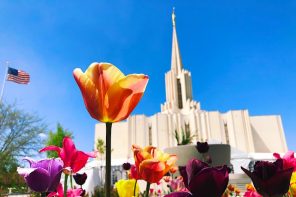Below is a recap of the first episode of Murder Among the Mormons, a new documentary released today by Netflix. Reviews of the next two episodes will appear on Thursday and Friday. An overview essay on the topic appeared here.
“It appears that dealing in Mormon documents can be a dangerous business.” -Steven Christensen
The first episode of Murder Among the Mormons closes with the Latter-day Saint choir singing the hymn, “We Thank Thee O God For a Prophet,” interspersed with video clips reflecting the escalating fear over the series of bombs in Salt Lake City, Utah, in October 1985. After the third explosion, this one in the car of Mark Hofmann, which followed two explosions the day before, the community was left terrified over whom the killer would target next.
The juxtaposition between a song that celebrates the certainty of having God’s spokesperson on earth, and the anxiety over an at-large serial killer, is not only an effective cinematic maneuver, but it also highlights a central paradox of 1980s America, something I’ll return to at the end of this recap.
Much of this inaugural episode is rightly devoted to setting the stage for the killings and introducing the key figures involved. But it also provides some, though arguably not enough, background for the cultural context. As I highlighted in my overview essay, 1980 was to be a breakout year for the Church of Jesus Christ of Latter-day Saints, as they celebrated the sesquicentennial and were enjoying a new record for national popularity. Cheesy videos from the LDS Visitors Center highlighted the faith’s devotion to families and traditional morals, an eerie prelude for the grisly events that followed.
Though most background information for Hofmann, including his personal history and forgery skills, is saved for a later episode, we’re introduced to Hofmann’s first documents, starting with the Anthon Transcript and culminating in the Salamander Letter. We’re also introduced to several of the people who surrounded Hofmann, like his close friends and colleagues Shannon Flynn, Brent Metcalfe, and Al Rust, all of whom were interviewed for this documentary. Perhaps the most surprising talking heads were Dorie Olds, Hofmann’s ex-wife who’s remained largely quiet to this point, and Richard Turley, who, until last summer, had held high-profile positions within the LDS Church.
The choice for other interviews shed insight on the documentary’s framing. Sandra Tanner, one of Mormonism’s most noted critics, provides color to the scandalous nature of Hofmann’s forgeries, which seemingly undercut traditional LDS narratives; Rod Decker, a longtime Utah journalist, dramatically details the cultural context. “Instead of God and angels, it’s salamanders and magic!” Tanner proclaimed; the letter was “a striking blow against the church,” professed Decker.
Notably, Murder Among the Mormons doesn’t rely on scholars to paint the era’s picture, at least on screen. (They did consult a handful of historians in preparation.) Directors Jared Hess and Tyler Measom are most interested in the drama and framework common in true crime series—an increasingly common genre on Netflix—rather than investigating the historical era. This is to be expected, of course, given the incredible popularity of “Murder Shows,” but it does have certain implications: the showrunners prioritize personalities over context, drama over background, and anxieties over broader significance.
This focus also condenses the story, with a majority of the series devoted to a half-decade, and the next two episodes primarily based in 1985 and 1986. Time constraints are always a difficult issue—not every documentary can be ten episodes—but by centering on the murders themselves, and the subsequent investigation, the show is forced to skip over most of the forgeries, the broader cultural relevance, and the long-lasting legacies.
The directors were also faced with the problem of how to handle Hofmann himself. Should he be treated as a genius? A monster? Something in-between? A common critique of true crime shows is that they highlight the brilliance of the perpetrator while overlooking the tragedy of the victims. Murder Among the Mormons does a decent job reminding viewers that innocent humans died due to Hofmann’s work, but the temptation to grant a degree of admiration to his crimes remains an issue throughout the series.
The documentary’s first episode concludes with the escalating tensions that resulted in the three bombs. Hofmann’s inability to finalize the sale of the Oath of the Freeman document, which would have solved all his financial woes, and his struggles to produce the complete “McLellin Papers,” which he had promised a number of Mormon collectors, left him scrambling. News clips from those long October days captured the heightened animosity after a first death, and then a second, launched Salt Lake City into a panic. The episode ends with the dramatic climax of policemen, journalists, and friends alike terrified that they had a serial killer running loose.
In his Bancroft Prize-winning book, historian Daniel Rogers defined the 1980s as an “Age of Fracture,” a period in which traditional foundations, affiliations, and assumptions seemed to fall apart. The decade had begun with such optimism and hope but ended with division and discord. The episode’s closing juxtaposition between the soothing chorus of an LDS hymn and the absolute panic of worried newscasters, therefore, succinctly capture the period’s paradox. Wasn’t religion meant to bring stability? What happens when, instead, it sows terror?
The next two episodes seek to answer that question, but instead of spanning out to see the wider society, they zoom in on the singular character of the killer behind the forgeries.





